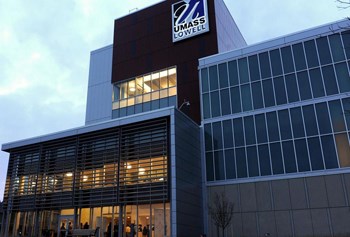
08/12/2014
Boston Globe
By Dan Adams
It’s a lofty goal for the onetime commuter school, which has long been seen as a little brother to the UMass system’s flagship campus in Amherst. But the effort has borne fruit, including a 45 percent jump in enrollment, an increasingly global student body, and the construction of nine new buildings around campus.
Tuesday, UMass Lowell took another step out of Amherst’s shadow by announcing a major partnership with giant Waltham-based defense contractor Raytheon Co., which will spend at least $3 million to establish a joint research facility focused on next-generation printable electronics and nanotechnology.
“Twenty years ago, UMass Lowell wasn’t growing, it wasn’t shrinking, it was just kind of status quo. Its purpose was educating the local population,” said Raytheon technical director Christopher McCarroll, who will supervise the company’s work with UMass Lowell. “Now, there’s a new emphasis on cutting-edge research. They’re really looking to make a mark as a research institute, and they’re doing all the right things in terms of getting noticed.”
The Raytheon-UMass Lowell Research Institute, or RURI, is set to open in October, and will occupy one floor of the school’s new $80 million Mark and Elisia Saab Emerging Technologies and Innovation Center.
UMass Lowell Chancellor Marty Meehan, a former congressman, hailed the move as a new model of industry-academia collaboration — and the latest sign of the university’s rising stock.
“UMass Lowell is really in transformation mode,” he said. “We’re not just growing the number of students, but also the amount of research and the quality of that research.”
To increase its research capabilities, the school has made large bets on industry partnerships, as with its New England Robotics Validation and Experimentation, or NERVE, Center, where prominent companies such as iRobot can test their robots in a massive indoor arena that features sand courses and a rain simulator.
But while schools and corporations frequently work together, the UMass Lowell-Raytheon deal entails unusually close cooperation, with students and company engineers working side-by-side on projects.
“Before, we followed a model where we would define the project, send money to the university, the university would work on it, and we’d come back and see how they were doing after a month,” said McCarroll. “With this model, we’re defining projects together and working on it with them there, elbow to elbow.”
The projects promise to be cutting-edge. Raytheon wants to refine new manufacturing processes that allow electronic circuits to be “printed out” with conductive “inks,” enabling the development of extremely thin or even flexible devices.
Such technology could help the company win military contracts by drastically shrinking its radar arrays, which are installed on ships and other vehicles where every ounce of weight and inch of space is prized. Printing circuits would also speed up development and manufacturing by eliminating the long wait for prototypes and products to arrive from expensive, polluting, and possibly unsecured overseas chip fabrication plants.
And the technology has many possible consumer applications, including wearable devices such as personal health monitors, making it a rich ground for patents and licensing deals. To that end, lawyers for Raytheon and UMass Lowell hashed out a detailed intellectual property sharing agreement.
While students stand to gain technical experience and professional connections, Raytheon gets an early look at a crop of young talent, an infusion of campus idealism, and a place for its employees to pursue advanced degrees.
“We employ thousands of engineers,” McCarroll said. “We need to keep them educated and feed the pipeline.”
Raytheon, which had 2013 sales of $24 billion and employs 63,000 people worldwide, has committed $3 million to building out the facility; if the program is successful, the company will contribute another $2 million toward expanding it. Depending on the project, research will be funded by federal grants, UMass, or Raytheon.
The collaboration fits neatly with UMass Lowell’s emphasis on hands-on, practical instruction. Meehan is unapologetic about the school’s cozy relationship with industry, saying students want — and deserve — real-world experience.
“Our faculty and research is totally independent, but we believe part of our mission is to work and collaborate with businesses and industry,” he said. “We want our research to be relevant.”
Industry partnerships also help students find work. Thanks to the school’s strong job placement rates and relatively low tuition — $12,447 for Massachusetts residents, and $27,400 for out-of-state students — Forbes ranked a UMass Lowell education as the 10th-best return on investment among US colleges.
“Higher education in this country needs to be more accountable,” Meehan said. “If a student comes and invests time and resources, we want to make sure they get as good and high-paying a job as they can.”
The project is a test-run for both sides: If it is successful, Raytheon may expand its existing partnerships with other universities, while UMass Lowell may strike similar deals with other companies.
“First, we want to earn that other $2 million,” Meehan said. After that, “we think other companies in Massachusetts and New Hampshire will look for ways to work with us. We think we can duplicate this model."
